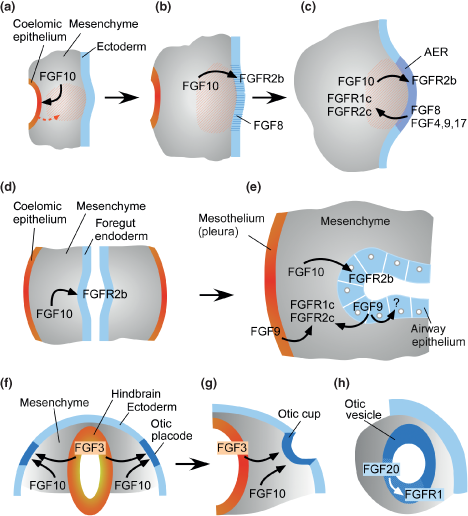File:LIMB BUD.png
LIMB_BUD.png (468 × 516 pixels, file size: 145 KB, MIME type: image/png)
Fibroblast growth factor involvement in limb bud development
Description
Mechanisms of FGF signaling during organogenesis. (a–c) Limb bud development uses a classical reciprocal epithelial-mesenchymal FGF signal. The earliest identified event in limb bud development involves an FGF10 signal to coelomic epithelium (a). This induces an epithelial to mesenchymal transition (orange arrow) that increases the amount of mesenchyme (orange hash) at the forming limb bud, resulting in a bulge. As development progresses (b), FGF10 signals to ectoderm to induce the formation of the apical ectodermal ridge (AER). Initially FGF8 (blue hash) is expressed throughout its length of the AER (b) and later FGF4, FGF9, and FGF17 are also expressed in the posterior half of the AER. AER FGFs signal to FGFR1 and FGFR2 in distal mesenchyme. (d, e) Lung development uses a modified reciprocal mesothelial/epithelial-mesenchymal FGF signal. The lung bud is initiated with an FGF10 signal from foregut mesenchyme to FGFR2b in foregut epithelium. Continued FGF10 expression is required for epithelial branching. Reciprocal signals from mesothelial FGF9 regulates mesenchymal proliferation through FGFR1 and FGFR2, while epithelial FGF9 functions as an autocrine factor to regulate epithelial branching through an as yet unidentified receptor. (f–h) Induction of the otic placode and differentiation of the otic vesicle. (f, g) FGF3, derived from the hindbrain and FGF10 derived from head mesenchyme, together, induce formation of the otic placode and its progression to the otic cup and otic vesicle. (h) After formation of the otic vesicle, FGF20 signals to FGFR1 within the prosensory epithelium (white hash) as a permissive autocrine factor required for differentiation of outer hair cells and outer supporting cells in the organ of Corti.
Reference
http://dx.doi.org/10.1002/wdev.176
<pubmed>25772309</pubmed>
This is an open access article under the terms of the Creative Commons Attribution-NonCommercial-NoDerivs License, which permits use and distribution in any medium, provided the original work is properly cited, the use is non-commercial and no modifications or adaptations are made.
File history
Click on a date/time to view the file as it appeared at that time.
| Date/Time | Thumbnail | Dimensions | User | Comment | |
|---|---|---|---|---|---|
| current | 10:06, 11 October 2016 |  | 468 × 516 (145 KB) | Z5015544 (talk | contribs) | =Fibroblast growth factor involvement in limb bud development= <br> <br> =Description= <br> Mechanisms of FGF signaling during organogenesis. (a–c) Limb bud development uses a classical reciprocal epithelial-mesenchymal FGF signal. The earliest ident... |
You cannot overwrite this file.
File usage
The following 2 pages use this file:
